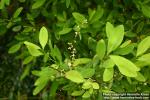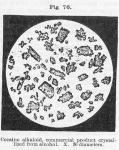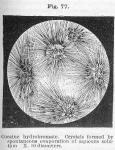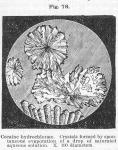 Preparation: Fluid Extract of Coca - Wine of Erythroxylon
Preparation: Fluid Extract of Coca - Wine of Erythroxylon
"The leaves of Erythroxylon Coca, Lamarck"—(U. S. P.). This is the ERYTHROXYLON of the U. S. P. of 1880.
Nat. Ord.—Lineae.
Botanical Source.—This is a shrub growing about 4 feet high, with the leaves ovate, alternate, thin, membranous, flat, opaque, acute at both ends, the apex almost mucronate, quite entire, tri-nerved in the middle with fine connecting veins on either side of the midrib, a slightly curved line extending from one end of the leaf to the other (the crossing of larger veins rendering the leaves somewhat areolated), dark-green above, paler beneath, 1 ½ to 2 inches long, an inch or more in their greatest width, and on short, delicate foot-stalks. The petioles are from 2 to 4 lines long, with a pair of intrapetiolary ovate-lanceolate, brown, acute stipules, upon the back of the outside of which the petiole is articulated, and from which the leaf readily falls away, leaving the branches scaly with the persistent stipules. The flowers are small, white, numerous, and borne in fascicles from the branches where the leaves have fallen away, bracteated. The peduncles are about as long as the flower, and sharply angled. Calyx 5-cleft, 5-angled at the base; segments acute. Petals 5, alternate with the calyx segments, oblong, concave, wavy, with a lacerated and much plaited membrane arising from within and above the base. Stamens 10, monadelphous; filaments longer than the pistil, combined below into a rather short cylindrical tube. Ovary oval, 3-celled, 3-seeded; styles 3, about as long as the ovary, distinct from the very base, not consolidated; stigmas thickened. The fruit (by abortion), is an oblong or ovoid drupe, 1-seeded, red, and obscurely furrowed when dry; the nut is oblong and furrowed (L.).
History.—Coca grows in moist and woody regions on the eastern slopes of the Andes, from 2000 to 10,000 feet above the level of the sea, and is highly valued and cultivated by the natives of Peru, Chili, and Bolivia, who make great use of it as a medicine, and as an article of diet. It answers as a substitute for the tea, coffee, tobacco, hashish, opium, etc., of other nations. In some sections the plant produces three crops annually. The natives masticate the dried leaves with finely powdered chalk or lime, or with a highly alkaline substance prepared from roasted potatoes and the ashes of various plants, which they call llipta. Its use is not confined to the rich; the poor laboring classes make great use of it as a stimulant and imaginary nutrient, as it enables them to endure fatigue and exertion for many hours, and even for several days, with but little nourishment of any other kind; and while under its influence they are said to perform prodigies of labor. The leaves after being gathered must be dried as quickly as possible, and be kept perfectly free from moisture and dampness; they then have a rather pleasant odor, recalling that of tea, and a bitter, aromatic, and slightly astringent taste.
Coca shrub has been cultivated successfully in Ceylon, India, and Java. In the latter country the cultivated species differ sufficiently from the Erythroxylon Coca to have been designated as the variety E. Coca, var. Spruceanum, Burck.
Description.—Two South American cocas are found in commerce. One known as Huanuco or Cuzco Coca, is derived from places of those names in Peru, the cities being located south of the central part of the state; and Truxillo or Trujillo Coca, coming from the northern portion of Peru. The latter kind has pale-green leaves, which are thin and easily broken, not so large but more pointed than those of Huanuco coca, which are coriaceous, thicker, and have a much deeper green color. The Truxillo leaf is said to be identical with that furnished by the Java shrub. Bolivian coca is regarded as finer than that grown in Peru. It is identical in appearance with the Huanuco variety. Coca is marketed in cestos or bags of from 25 to 50 pounds each. The U. S. P. thus describes coca: "Varying between ovate, lanceolate, and obovate-oblong, and from 2 to 5 or 7 Cm. (¾ to 2 or 2 ¾ inches) in length; short-petiolate, entire, rather obtuse or emarginate at the apex, slightly reticulate on both sides, with a prominent midrib, and on each side of it a curved line running from base to apex; odor slight and tea-like; taste somewhat aromatic and bitter. When chewed it temporarily benumbs the lips and tongue"—(U. S. P.).
 Chemical Composition.—Wackenroder, in 1853, failed to isolate any of the active principles of coca leaves, but obtained its peculiar tannic principle to which later the name coca-tannic acid was given. Several alkaloids have since been observed in coca. Cocaine (C17H21NO4), was first noticed by Gaedeke, in 1855, who named it erythroxiline, but it was better defined by Niemann, in 1860, who gave it its present name. When heated with concentrated hydrochloric acid, it is resolved into benzoic acid, methyl alcohol, and a new base called ecgonine (C9H15NO3, or CH3.NC5H7.CHOH.CH2.COOH); hence cocaine is methyl-benzoyl-ecgonine (W. Lossen, 1862). Ecgonine crystallizes from alcohol in monoclinic prisms, easily soluble in water, less so in alcohol, and insoluble in ether. It has a sweetish bitter taste. COCAINE occurs in large 4 to 6-sided monoclinic prisms, and when pure, is without odor and color. Cocaine is readily soluble in chloroform, ether, carbon disulphide, benzene, petroleum ether, petroleum (melted), and in volatile and fixed oils. It is much less soluble in alcohol than in the above solvents, while water dissolves it with difficulty (1 part in 704 at 12° C. [53.6° F.]) (Niemann); more than 1300 parts of cold water (Paul), being required. Cocaine is bitterish, and produces upon the tongue an evanescent numbness. It can not be kept in aqueous solution on account of its tendency to split into methyl-alcohol, ecgonine, and benzoic acid. Cocaine is strongly alkaline in reaction, producing with acids crystallizable salts, which, as a rule, are bitter, and dissolve freely in water and alcohol. Ether does not dissolve them. They all possess the property of benumbing the tongue in a greater degree than does the alkaloid cocaine. For the details of Squibb's process of preparing cocaine by percolating coca leaves with a 5 per cent solution of sulphuric acid, and abstracting the alkaloid with kerosene oil after rendering alkaline with sodium carbonate, see Ephemeris, 1887, p. 906.
Chemical Composition.—Wackenroder, in 1853, failed to isolate any of the active principles of coca leaves, but obtained its peculiar tannic principle to which later the name coca-tannic acid was given. Several alkaloids have since been observed in coca. Cocaine (C17H21NO4), was first noticed by Gaedeke, in 1855, who named it erythroxiline, but it was better defined by Niemann, in 1860, who gave it its present name. When heated with concentrated hydrochloric acid, it is resolved into benzoic acid, methyl alcohol, and a new base called ecgonine (C9H15NO3, or CH3.NC5H7.CHOH.CH2.COOH); hence cocaine is methyl-benzoyl-ecgonine (W. Lossen, 1862). Ecgonine crystallizes from alcohol in monoclinic prisms, easily soluble in water, less so in alcohol, and insoluble in ether. It has a sweetish bitter taste. COCAINE occurs in large 4 to 6-sided monoclinic prisms, and when pure, is without odor and color. Cocaine is readily soluble in chloroform, ether, carbon disulphide, benzene, petroleum ether, petroleum (melted), and in volatile and fixed oils. It is much less soluble in alcohol than in the above solvents, while water dissolves it with difficulty (1 part in 704 at 12° C. [53.6° F.]) (Niemann); more than 1300 parts of cold water (Paul), being required. Cocaine is bitterish, and produces upon the tongue an evanescent numbness. It can not be kept in aqueous solution on account of its tendency to split into methyl-alcohol, ecgonine, and benzoic acid. Cocaine is strongly alkaline in reaction, producing with acids crystallizable salts, which, as a rule, are bitter, and dissolve freely in water and alcohol. Ether does not dissolve them. They all possess the property of benumbing the tongue in a greater degree than does the alkaloid cocaine. For the details of Squibb's process of preparing cocaine by percolating coca leaves with a 5 per cent solution of sulphuric acid, and abstracting the alkaloid with kerosene oil after rendering alkaline with sodium carbonate, see Ephemeris, 1887, p. 906.
 Cocaine may also be considered a methyl derivative of benzoyl-ecgonine (C9H14NO3.COC6H5), which is another alkaloid occurring in coca leaves. Isatropyl-cocaine (C19H23NO4), a very poisonous, amorphous alkaloid, has also been found in this drug (Liebermann, 1888). With hydrochloric acid it splits into methyl-alcohol, ecgonine, and isatropic acid (C8H7.COOH), thus disclosing an analogy to cocaine, the relationship being similar to that exhibited in the class of alkaloidal bodies known as tropeïnes (see Atropine). Cinnamyl-cocaine (C19H23NO4), another alkaloid existing in coca leaves, is likewise analogous to cocaine, yielding by decomposition cinnamic acid (Geisel), or isocinnamic acid (Liebermann, 1890), instead of benzoic acid. Cocamine (C19H23NO4, Hesse, 1889), being present in Erythroxylon nova granatense, or Truxillo bark, in the amount of 0.6 per cent, yields cocaic acid (C9H8O2), which Hesse pronounces, however, identical with isatropic acid. Liebermann and Geisel (1891), found in coca leaves from Java benzoyl-pseudo-tropeine (C15H19NO2), which, when heated with hydrochloric acid, splits off pseudo-tropine (C8H15NO). The alkaloid hygrine, named by Lossen, was previously observed by Maclagan. According to Hesse (1887), it is a yellowish, strongly basic oil easily soluble in ether, chloroform, and alcohol, less so in water, forming salts with acids. Its diluted solutions in acids are fluorescent. Its formula is probably C12H13N, which points to its being a homologue of quinoline (C9H7N). Cocaicine
Cocaine may also be considered a methyl derivative of benzoyl-ecgonine (C9H14NO3.COC6H5), which is another alkaloid occurring in coca leaves. Isatropyl-cocaine (C19H23NO4), a very poisonous, amorphous alkaloid, has also been found in this drug (Liebermann, 1888). With hydrochloric acid it splits into methyl-alcohol, ecgonine, and isatropic acid (C8H7.COOH), thus disclosing an analogy to cocaine, the relationship being similar to that exhibited in the class of alkaloidal bodies known as tropeïnes (see Atropine). Cinnamyl-cocaine (C19H23NO4), another alkaloid existing in coca leaves, is likewise analogous to cocaine, yielding by decomposition cinnamic acid (Geisel), or isocinnamic acid (Liebermann, 1890), instead of benzoic acid. Cocamine (C19H23NO4, Hesse, 1889), being present in Erythroxylon nova granatense, or Truxillo bark, in the amount of 0.6 per cent, yields cocaic acid (C9H8O2), which Hesse pronounces, however, identical with isatropic acid. Liebermann and Geisel (1891), found in coca leaves from Java benzoyl-pseudo-tropeine (C15H19NO2), which, when heated with hydrochloric acid, splits off pseudo-tropine (C8H15NO). The alkaloid hygrine, named by Lossen, was previously observed by Maclagan. According to Hesse (1887), it is a yellowish, strongly basic oil easily soluble in ether, chloroform, and alcohol, less so in water, forming salts with acids. Its diluted solutions in acids are fluorescent. Its formula is probably C12H13N, which points to its being a homologue of quinoline (C9H7N). Cocaicine  (Bender, 1885), is one of several undetermined coca alkaloids. Among other constituents of coca leaves may be mentioned, chlorophyll, resin, traces of essential oil, the coca-tannic acid before mentioned producing a green-black color with ferric salts; a wax crystallizing from alcohol in white granules, and melting at 70° C. (158° F.) (Niemann), and inorganic salts. The amount of total alkaloids in coca leaves has been found to vary from 0.2 to 0.8 per cent, seldom reaching 1 per cent. For comparisons of assay methods, see Amer. Jour. Pharm., 1895, pp. 489 and 572.
(Bender, 1885), is one of several undetermined coca alkaloids. Among other constituents of coca leaves may be mentioned, chlorophyll, resin, traces of essential oil, the coca-tannic acid before mentioned producing a green-black color with ferric salts; a wax crystallizing from alcohol in white granules, and melting at 70° C. (158° F.) (Niemann), and inorganic salts. The amount of total alkaloids in coca leaves has been found to vary from 0.2 to 0.8 per cent, seldom reaching 1 per cent. For comparisons of assay methods, see Amer. Jour. Pharm., 1895, pp. 489 and 572.
Action, Medical Uses, and Dosage.—In large doses, coca is said to cause delirium, hallucination, and finally cerebral congestion. In medium doses it acts as a stimulant, increasing the temperature of the body, as well as the respiration and frequency of the pulse; in a moderate dose it excites the nervous system in such a manner as to render the performance of muscular exertion much easier, and producing a sensation of calmness. According to Dr. Mantegazza, its use has produced an erythematous eruption resembling pityriasis, with a sense of prickling and itching; the intoxication produced by it, differs from that resulting from the use of alcoholic drinks, the symptoms being feverishness, increased heat of the surface, palpitation, photopsy, headache, vertigo, increased frequency of the pulse, a peculiar roaring tinnitus, strong desire for active locomotion, with increased sense of strength and agility, exaltation of the intellectual sphere, sense of isolation, followed by a feeling of intense calm and comfort, complete apathy, sleep, odd and rapidly changing dreams, and from which the patient awakes without debility or indisposition of any kind. The leaves of coca, chewed or taken in a weak infusion, stimulate the gastric nerves and greatly facilitate digestion; and are also useful in relieving the sense of fatigue from excessive mental or physical exercise. A drachm of the leaves chewed produces a feeling of comfort in the stomach, and upon repeating the dose a few times, a slight burning sensation is experienced in the mouth and pharynx, with increased thirst, rapid digestion, and a substitution of the coca odor in the stools for that ordinarily present.
More recently, M. Moreno, who made some interesting experiments upon the effects of coca and cocaine, remarks, that coca gives much less arterial tension than coffee, as he has convinced himself with the aid of the sphygmograph. Relatively to its action, M. Weddell has observed: "One of two things, either coca incloses some nutritive principles which directly sustain the forces, or else it simply deceives the hunger, by acting upon the economy as an excitant." M. Moreno has submitted animals to an insufficient alimentation or to absolute inanition, and in these conditions be has observed that those to whom he administered coca lost more of their weight and died more speedily. He concludes that if coca sustains the forces, that is to say, permits man to forget hunger, it is not, however, as an aliment, and does not succeed in satisfying it. He has carefully studied the special action exerted by this substance upon the nervous system. According to him it determines (1) phenomena which place it with strychnine (tetanic and spontaneous convulsions, and, upon the least excitation of the animals, death); (2) in a small dose, it provokes a remarkable excitation of sensibility, dilatation of the pupil, irregularity of the movements; the animals seem to have lost the coördinating power of their movements. Lastly, in large doses, it causes a diminution, followed by exhaustion, of sensation, without motility being completely abolished, and in all the cases, the pupils remain dilated. Like tea and coffee, coca lessens the elimination of urea, acting thereby indirectly as a food, though not a food in itself. That hunger is staved off by it is probably due to a benumbing effect upon the nervous supply of the stomach.
That the habit of using coca will grow upon one, is illustrated by its effects upon the mountaineers of the Peruvian Andes (see History), who employ it to lessen fatigue, and to guard against the pulmonary hemorrhage likely to occur at high altitudes. The habitual coca-chewer acquires a general apathetic state and his step becomes uncertain. Deep purplish circles surround big sunken eyes, his lips tremble, a peculiar blackish colorization is observed at the angles of the mouth, the teeth become green and encrusted, and an intolerably offensive odor is imparted to the breath. Extreme emaciation, with intractable sleeplessness, and anasarca ensue and finally death completes the destruction.
Coca is a remedy for defective innervation, as evidenced by imperfect digestion, even though the appetite remains normal, and when the disorder is associated with occipital and post-cervical pain, vertigo and inability to stand for any length of time (Scudder). It increases the flow of gastric juice, improves the tone of the stomach, and relieves gastric pain. In fact, atonic states of the nervous system and the stomach, are the conditions in which it appears to exert the best effects. Hysteria is often cured by it, while, in chorea, it may relieve by toning the muscles and increasing nerve power, in this manner giving the patient better control over the muscular movements. From 10 to 15 drops of specific erythroxylon will overcome insomnia, caused by a gloomy state of the mind, and sometimes asthma is slowly, but permanently, cured by the drug (Locke). In the treatment of the opium habit it generally fails.
Coca has been successfully used in irritative or atonic dyspepsia, flatulency, colic, gastralgia, enteralgia, hypochondria, spinal irritation, idiopathic convulsions, nervous erethism, and in the debility following severe acute affections, anemia, scurvy, etc. In large doses it has been proposed in tetanus and hydrophobia, though no trustworthy reports of its efficacy are as yet forthcoming. Prof. Scudder (Spec. Med.) suggests that it may be useful in "the early stages of tuberculosis, by enabling the person to take the exercise so much needed to burn the imperfect materials in the blood." There is no doubt but that it exerts some control in wasting diseases in general. It is reputed useful in relaxed states of the vocal chords, and in the granular form of pharyngitis; and to allay the thirst accompanying diabetes, and the inordinate hunger of the insane and epileptics. Like tea, coffee, guarana, etc., it is an effectual remedy in migraine, or nervous headache, and is not without utility in functional impotence an spermatorrhoea, when due merely to a condition of general debility. Coca has been suggested as an agent to control hunger, thirst, and fatigue for armies during long and forced marches, but, owing to its scarcity, it will probably never be used for this purpose.
Three or 4 drachms of the leaves is a medium dose, whether chewed or used in infusion; of the hydro-alcoholic extract, 10 to 15 grains, in pill form; the dose of specific erythroxylon is from 5 to 30 drops.
Specific Indications and Uses.—Defective innervation with dizziness, impaired digestion, occipital and post-cervical pain, and inability to stand for a length of time; migraine; fatigue; weariness and mental and physical exhaustion; labored and difficult breathing, with normal temperature; inordinate hunger and thirst.

